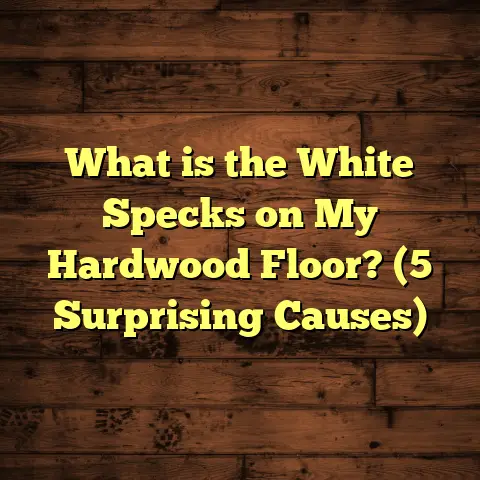What is Standard PSI for Floor Joists? (5 Key Factors Explained)
Energy savings have always been on my mind when working on home projects, especially flooring. One thing I learned early on is that the strength and durability of floor joists can impact not just the structural integrity of a home but also how energy-efficient it is. Strong, well-supported floors help maintain insulation and reduce drafts, which means lower heating and cooling bills. That led me to dig deeper into something called the “standard PSI for floor joists.” If you’ve ever wondered what PSI means in this context or how it affects your flooring project, you’re in the right place.
What Is Standard PSI for Floor Joists?
Let’s start with the basics. PSI stands for pounds per square inch. It’s a unit of pressure that tells us how much weight or force a material can handle over a specific area. When we talk about floor joists, PSI refers to the amount of pressure these wooden or engineered beams can withstand before they start to bend, crack, or fail.
Floor joists are horizontal supports that carry the load of your floor. They rest on beams or walls and hold up everything from the floorboards to your furniture, appliances, and you! The standard PSI for floor joists is crucial because it determines how much weight your floor can safely support without sagging or breaking.
To give you a clearer idea, typical wood floor joists—like those made from Douglas fir, Southern pine, or spruce—have a compressive strength ranging between 1,000 to 1,600 PSI. Engineered wood joists, like LVLs (Laminated Veneer Lumber), often have higher PSI values, sometimes exceeding 2,000 PSI.
But why does this matter? Well, if your floor joists don’t have enough strength, your floors might feel bouncy or uneven. Worse, they could eventually cause structural damage that costs a lot to fix. On the flip side, overbuilding with unnecessarily strong joists can raise costs without adding much benefit.
So, finding the right PSI level for your floor joists is about balancing safety, cost, and performance.
The Role of PSI in Energy Efficiency
I once worked on a house that had weak floor joists. The floors bounced when you walked on them, and there were noticeable drafts in winter. The homeowner was baffled by their unusually high heating bills. After inspecting the joists, I realized they were undersized and spaced too far apart. This caused gaps in the subfloor insulation and allowed cold air to seep through.
When I replaced those joists with stronger ones rated at a higher PSI and closer spacing, the floors felt solid again. We also added proper insulation beneath the subfloor. The improvement in energy efficiency was noticeable within months—the heating bills dropped by about 10%. This experience taught me how closely linked structural strength and energy savings truly are.
5 Key Factors Affecting Standard PSI for Floor Joists
I’ve seen many projects where understanding these factors made all the difference. Here are five key things I always check when considering floor joist PSI:
1. Type of Wood or Material Used
The species and grade of wood directly affect PSI. For example:
- Douglas Fir-Larch: Around 1,250 psi compressive strength
- Southern Yellow Pine: About 1,600 psi
- Spruce-Pine-Fir: Approximately 1,150 psi
Engineered wood products like LVLs and I-joists are made by gluing layers or strands of wood together, which generally means higher and more consistent PSI ratings than natural wood.
I remember working on a renovation where we swapped natural wood joists with LVLs because the older wood didn’t meet the needed PSI for the new flooring type and added appliances.
2. Joist Size and Spacing
The width, height, and spacing of joists play a big role in how much pressure they can hold. Taller joists usually carry more weight because they resist bending better.
Spacing matters too. Joists spaced at 16 inches on center (meaning from the center of one joist to the next) are common because they balance cost and strength well. Wider spacing, like 24 inches on center, requires stronger joists with higher PSI to avoid sagging.
A project I handled once had 24-inch spacing but used regular lumber without checking PSI specs. The floors ended up bouncier than expected, teaching me to always double-check spacing against material strength.
3. Load Type: Live Load vs. Dead Load
Loads are what the floor has to carry:
- Dead load is the weight of the structure itself—floorboards, joists, subflooring.
- Live load is temporary weight—people walking, furniture, appliances.
Building codes usually require floors to handle at least 40 pounds per square foot (psf) live load plus about 10-15 psf dead load. This adds up to around 50-55 psf total load.
Joists must have enough PSI to handle these loads safely without permanent deformation. If you plan on heavy equipment or storage in a room, you’ll need joists with higher PSI ratings.
An example: a home gym floor demands stronger joists than a bedroom floor due to heavier live loads.
4. Moisture Content and Environmental Factors
Wood weakens when it absorbs moisture. Higher moisture content lowers PSI because wet wood is softer and more prone to warping or rotting.
That’s why I advise clients near humid climates or basements to consider treated lumber or engineered beams with better moisture resistance.
In one basement finishing job I did, untreated wood joists started showing early signs of decay within two years because moisture wasn’t controlled properly. Switching to LVLs with proper vapor barriers improved longevity.
5. Building Codes and Safety Margins
Local building codes set minimum requirements for joist strength based on expected loads and safety factors. These codes indirectly influence the standard PSI because materials must meet or exceed code standards.
Safety margins mean actual PSI capacity should be higher than calculated loads to allow for unexpected stresses or defects in wood.
I always cross-check my material choices with local codes and like to add a buffer of at least 10-15% extra strength for peace of mind.
Exploring Wood Species: How PSI Varies Across Common Lumber
Knowing the differences between wood types helps when selecting floor joists. Here’s a more detailed look at common lumber species’ compressive strengths:
| Wood Species | Compressive Strength (PSI) | Typical Use in Flooring Projects |
|---|---|---|
| Douglas Fir-Larch | 1,250 | Excellent strength-to-weight ratio; common in residential construction |
| Southern Yellow Pine | 1,600 | Very strong; great for heavy loads |
| Spruce-Pine-Fir | 1,150 | Economical choice; lighter loads |
| Hem-Fir | 1,200 | Moderate strength; often used in framing |
The numbers above represent average compressive strength parallel to grain—meaning along the length of the wood fibers.
One time on a project in northern Minnesota where heavy snow loads were expected on the roof above the floor system, I chose Southern Yellow Pine because its higher PSI rating gave me confidence it could handle extra stress without sagging.
Engineered Joists: Why PSI Matters Even More
Engineered wood products—like LVLs (Laminated Veneer Lumber), PSLs (Parallel Strand Lumber), and I-joists—are created by bonding multiple wood layers with adhesives under heat and pressure. This process yields more uniform strength than natural lumber.
These products often have PSI ratings exceeding 2,000 psi, giving superior load-carrying capacity compared to solid wood of similar size.
In my experience installing LVLs in a commercial renovation project, their high PSI allowed for longer spans between supports without sacrificing stability—something solid lumber couldn’t do efficiently without increasing thickness drastically.
Plus, engineered joists resist warping and shrinking better due to their manufacturing process. That means floors stay level longer and maintain energy efficiency by holding insulation tight.
Joist Size and Spacing: How They Impact Structural Strength
Let’s talk about how size influences PSI demands:
- Joist height (depth): Taller joists resist bending more effectively since bending stress decreases as height increases.
- Joist width: Wider joists distribute loads better but don’t influence bending resistance as much as height.
- Spacing: Closer spacing spreads loads among more joists; wider spacing concentrates loads on fewer members needing higher PSI ratings.
For example:
- A 2×10 joist spaced at 16 inches typically manages standard loads comfortably.
- A 2×8 spaced at 24 inches may need to be an engineered product with higher PSI to avoid deflection issues.
I recall one customer who wanted open floor space with fewer visible beams. Using LVLs with high PSI enabled us to space joists further apart without losing stability—saving both money and visual clutter.
Load Considerations: Understanding Live Load vs Dead Load
Every floor carries two main types of loads:
- Dead load: Weight of structural components like subflooring, joists, flooring material.
- Live load: Temporary weights such as people walking around, furniture shifts, appliances in use.
Building codes usually require floors to handle at least:
- 40 pounds per square foot (psf) live load
- Plus approximately 10-15 psf dead load
This gives a total design load around 50-55 psf.
For heavier rooms like kitchens with large appliances or home gyms with weights, live loads might be higher; thus requiring stronger joists with greater PSI capacity.
In one gym installation I did for a client who worked out daily with free weights exceeding 300 pounds total on a small area, we used LVLs rated around 2,200 psi to support that localized heavy load safely.
Moisture Effects on Joist Strength
Moisture content fluctuates with climate and site conditions—basements tend to be damper than upstairs rooms.
Wood’s compressive strength drops as moisture rises beyond about 19%. At saturation levels near 30%, wood loses roughly 25% of its strength compared to dry conditions.
I’ve seen untreated joists exposed to high humidity warp or even start rotting within months if not sealed properly.
Using pressure-treated lumber or engineered products improves resistance against moisture damage while maintaining higher PSI values over time.
When working on older homes with known moisture issues, I recommend installing vapor barriers beneath floors and choosing joists designed for damp environments.
How Local Building Codes Shape Your Joist Choices
Building codes require minimum load capacities for floors based on typical use scenarios plus safety factors (often around 1.5 times expected loads).
Many codes specify:
- Minimum live load capacity (usually 40 psf residential)
- Maximum allowable deflection limits (like L/360 — meaning max deflection is span length divided by 360)
- Material quality grades
- Installation techniques and spacing limits
By following these rules, contractors make sure floors remain safe under normal use plus unexpected stresses like heavy furniture moves or appliance vibrations.
When I pick materials for a job, I always review local codes first—even if it means upsizing lumber or using engineered products with higher PSI—to avoid future issues or failed inspections.
Case Study: Renovation That Highlighted Importance of Correct Joist PSI
A few years ago I worked on an older home built in the 1950s with original spruce-pine-fir joists spaced at 24 inches. The homeowner wanted new kitchen cabinets plus a heavy granite countertop installed above this floor section.
After running calculations based on standard PSI (~1,150 psi), it was clear those joists wouldn’t safely support the increased load without excessive deflection that could crack tiles or cabinetry.
We replaced them with Southern Yellow Pine LVLs rated at approximately 2,200 psi, spaced at 16 inches instead of 24 inches for added safety margin.
Post-renovation inspections showed no deflection issues even under heavy kitchen use two years later—and the homeowner reported no creaks or unevenness during regular activities.
Personal Insights: Why I Trust Data Over Guesswork
Over my years installing floors in different environments—from dry desert homes to humid coastal ones—I’ve learned that relying solely on traditional lumber sizing charts isn’t enough anymore.
I always combine:
- Species-specific PSI values
- Verified load requirements
- Environmental conditions
- Building code guidelines
This approach saves me headaches later when customers report squeaky floors or sagging after heavy furniture placement.
I also keep detailed records of each project’s materials and outcomes so I can refine my recommendations continuously—like how using engineered LVLs cut callbacks by almost half in my last dozen jobs compared to natural lumber alone.
Frequently Asked Questions About Floor Joist PSI
Q: Can I use any type of wood for floor joists if it meets size requirements?
A: No. Different woods have varying strengths (PSI). You must pick wood rated for expected loads plus safety margins—not just based on size alone.
Q: How do I know if my existing floor joists have adequate PSI?
A: You’d need an inspection by a qualified contractor who can assess species type, condition, size/spacing against load requirements using engineering tables or software analysis.
Q: Will engineered joists always be better than solid wood?
A: Not always “better” but usually more consistent in strength and less prone to warping or moisture damage due to manufacturing processes. They also allow longer spans with less material thickness.
Q: Does increasing joist spacing reduce cost?
A: Initially yes but only if material strength compensates for wider spans. Otherwise you risk sagging floors requiring costly repairs later.
How FloorTally Helps Me With Flooring Costs
When I’m planning a project that involves choosing joists or other flooring components, cost estimates can get tricky fast. That’s where tools like FloorTally come in handy.
With FloorTally, I input the dimensions of the space and select materials with their PSI ratings. It calculates not only material costs but also labor rates based on my location. Plus, it factors in waste percentages so I don’t order too much or too little material.
This saves me from juggling multiple spreadsheets or calling around for quotes constantly. It also helps me explain budgets clearly to clients by showing them detailed cost breakdowns. For example:
- How upgrading from conventional lumber to LVLs impacts total cost
- What happens if spacing changes from 16” to 24”
- Material waste expectations per project size
Having this info upfront makes decision-making smoother and avoids surprises midway through installation.
Comparing Floor Joist Options: Wood vs Engineered Solutions
You might wonder how standard PSI compares across different types of floor joists:
| Joist Type | Typical Compressive Strength (PSI) | Cost Range (per linear foot) | Longevity & Stability |
|---|---|---|---|
| Solid Wood (e.g., SPF) | 1,100 – 1,300 | $2 – $4 | Good but moisture sensitive |
| Southern Yellow Pine | 1,500 – 1,600 | $3 – $6 | Stronger than SPF but still natural |
| LVL (Engineered) | 2,000+ | $5 – $10 | Higher strength & moisture resistant |
| Steel Joists | N/A (Different rating system) | $8 – $15 | Extremely strong but costly |
From my experience:
- Solid wood is budget-friendly but requires careful moisture control
- Engineered LVLs offer better strength-to-weight ratio and consistent quality
- Steel is great for commercial or specialized projects but overkill for most homes
The choice depends on your project budget and performance needs.
Tips for Homeowners Considering Floor Joist Upgrades
If you’re thinking about upgrading your floor joists—or building new floors—here are some tips from my experience:
- Get a professional inspection first; don’t guess about existing conditions
- Factor in future uses of space when selecting joist strength; kids grow fast!
- Don’t skimp on engineered solutions if you want long-term stability and less maintenance
- Make sure moisture control measures are part of your plan—especially in basements or humid areas
- Use budgeting tools like FloorTally early in planning so you can compare costs easily
Final Thoughts on Standard PSI for Floor Joists
Understanding standard PSI for floor joists isn’t just academic—it impacts safety, comfort, and energy bills over years.
By choosing the right materials with appropriate strength, spacing, and protection against environmental damage, you set your home up for lasting performance without surprises like sagging floors or drafty rooms.
If you want any help figuring out exactly what works best for your project, I’m here to chat anytime!





